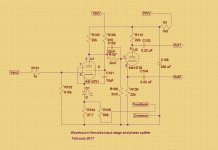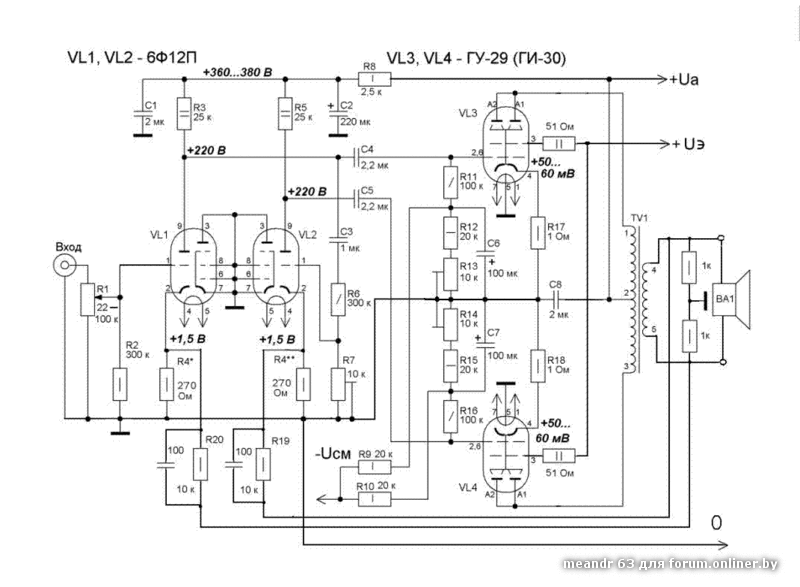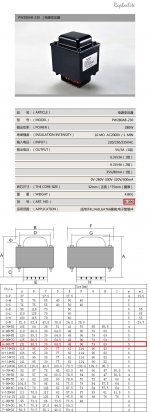That's similar to the voltage at my place - 116.5 V right now, though sometimes it changes at different times of day.House was built in 1967 - 115.7 VAC at the socket - that may answer the delta😕
So you can't attribute the higher than expected voltages on the (unloaded) heaters to high wall voltage. Not to worry, things may settle down once the transformer gets the load applied with the tubes.
Nice compact boards.
Not the schematic to send to a beginner, though! (Joking...) 😀
Does it look better now? 🙂
Attachments
GreetingsDoes it look better now? 🙂
Explain why you need to supply 370 volts of power if the output lamp is optimal for 250,
There are other sources for heating the apartment 😉
Is there no bottom plate (safety cover on bottom of amp) on the Boyuu? And, are there ventilation holes in the top plate of the amplifier? I don't understand how the cooling air passes through the amp. Well-designed low power tube amplifiers (with safety covers) have operated for many years in the past without fans for cooling......using natural convection cooling when necessary.
Hello !
This fan cools the chassis and there are ventilation holes on the side of the chassis Boyuu A09 !
The fan I installed on the support of the amp allows the chassis of it to remain warm even after long hours of operation.
Gidu
Last edited:
Greetings
Explain why you need to supply 370 volts of power if the output lamp is optimal for 250,
There are other sources for heating the apartment ��
What 250? Where did you get that?
It is a split-load phase splitter, drives control grids of output tubes, biased to -22V.
What swing on anode and cathode does it need to drive them? What idle voltage between anode and cathode it needs to do that?
Can you calculate that? It will be your answer.
I am even afraid to ask you about "heating the apartment" by 1-10 mA current...
I have to apologize, what we discussed with John, was off-topic, regarding using printed boards in tube amplifiers. Back on topic, you mentioned that we in USSR designed transformers that did not waste power. It is not true. We designed transformers according to 2 criteria, for temperature raise, and for voltage drop. For power transformers it was usually 10% voltage drop, and a temperature raise according to environmental conditions and used insulation. Nothing have changed since then, however sellers of kits sometimes sell parts of failed projects, when the design can not be used to sell based on it finished production, due to errors.
I see the picture, thank you. But can you please answer my questions before we discuss your picture?
I agree with you,Nothing have changed since then, however sellers of kits sometimes sell parts of failed projects, when the design can not be used to sell based on it finished production, due to errors.
I apologize if you misunderstand me. Regarding heating is a joke. 🙂
In my amplifier A10, which worked for one month, there was a short circuit between the turns of the winding (failure).
Why did the "boyuu" reduce the transformer power in the A10 amplifier model?

Last edited:
Here is one of books that we used in ТИАСУР to learn to design transformers:
http://padabum.com/x.php?id=1588
Nothing have changed since then, except new better materials become available.
http://padabum.com/x.php?id=1588
Nothing have changed since then, except new better materials become available.
The consumer wants quality for reasonable money.Nothing have changed since then, except new better materials become available.
in practice so YouTube
The consumer wants quality for reasonable money.
in practice so YouTube
Money you spend for made in China transformers and kits is unreasonably low. We can't get such prices here in USA even when manufacture transformers in Mexico.
It is DIY Audio, you are free to tweak what you get, for optimal results. Overheating transformers? Well, you need to draw less power. How? Decrease idle current. How? Either increase the value of cathode bias resistor, or decrease voltage on the screen grid, adding one resistor and a capacitor. 1.5 times less power as the result that was promised? Well, it was a wrong promise. And 1.5 times difference in power is barely audible.
I actually chose the A10 because of the beautiful polished stainless steel from which the amplifier body was made. I realized that I would not get any increase in power from the A10. Now ordered a power transformer, which costs three quarters of the cost of the amplifier 🙂 This is called I saved myself from extra money. (Joke).Well, it was a wrong promise. And 1.5 times difference in power is barely audible.
Attachments
TANSTAAFL is reality!  With care, you get what you pay for. It's not possible to buy a "Caddy" at a "Chevy" price. Lack of attention can have you paying for a "Caddy", but getting a "Chevy".
With care, you get what you pay for. It's not possible to buy a "Caddy" at a "Chevy" price. Lack of attention can have you paying for a "Caddy", but getting a "Chevy".
When the price is low, due to tiny Chinese labor costs, you can get nice cosmetics or OK performance. To get both, even from a Chinese source, increases the price. Only trouble comes free. You don't have to search it out, as it will find you. 🙁
 With care, you get what you pay for. It's not possible to buy a "Caddy" at a "Chevy" price. Lack of attention can have you paying for a "Caddy", but getting a "Chevy".
With care, you get what you pay for. It's not possible to buy a "Caddy" at a "Chevy" price. Lack of attention can have you paying for a "Caddy", but getting a "Chevy".When the price is low, due to tiny Chinese labor costs, you can get nice cosmetics or OK performance. To get both, even from a Chinese source, increases the price. Only trouble comes free. You don't have to search it out, as it will find you. 🙁
Good words and definitely definitely said.Only trouble comes free. You don't have to search it out, as it will find you. 🙁

You can check for yourself. 3.5K 10W would mean a RMS voltage as a square root from 35,000, i.e. 187V. An RMS current would be 187/3.5, i.e. about 54 ma, that means peak of 76 mA. If the voltage between anode and cathode is 350V, the tube should dissipate no less than 27W, if it is an ideal tube that can deliver 50% efficiency. Can such an amp produce promised 12W per channel? No way!
I do not chase for power, I am satisfied with 5~8 watts. I love listening to music at a low volume. When replacing the transformer will have to align the mode of operation. Now I can not turn on the amplifier, it sparkles in the transformer.
The optimum temperature of the transformer is 60-65 degrees. Normal is considered the temperature of 60-90 degrees. Most transformers are designed for this temperature range, and the maximum permissible overload temperature is 120 degrees.
If the transformer power is greater than the required, then it is always good. More powerful transformers have higher efficiency. For example, a transformer with a capacity of 3-5 watts may have an efficiency of only 50%, while for transformers with a capacity of 50–100 watt, the efficiency is usually about 90%.
The optimum temperature of the transformer is 60-65 degrees. Normal is considered the temperature of 60-90 degrees. Most transformers are designed for this temperature range, and the maximum permissible overload temperature is 120 degrees.
If the transformer power is greater than the required, then it is always good. More powerful transformers have higher efficiency. For example, a transformer with a capacity of 3-5 watts may have an efficiency of only 50%, while for transformers with a capacity of 50–100 watt, the efficiency is usually about 90%.
Last edited:
- Home
- Amplifiers
- Tubes / Valves
- Boyuu EL34 A9 Tube Amp


